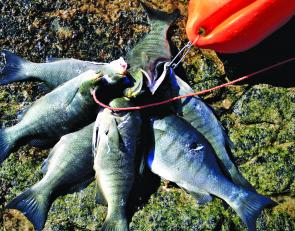Last month we talked about some of the best places to rock hop while spearfishing, this months we move on the to deciding which gear to use and when.
Gear choice when rock hopping is extremely variable. Some rock hoppers will actually be swimming a significant distance offshore and so require very similar gear to what they may use if they were offshore in a boat. If you only intend to hug the coast, a shorter pair of fins can be useful.
Very long fins are extremely ungainly when trying to walk across rocks to enter the water, and are similarly difficult to manage when exiting. They can also be prone to breaking if you get them hooked on some rocks. Certainly long carbon type fins are usually not warranted; a pair of mid-sized plastic fins are usually adequate.
Remember you are generally not diving as deep when rock hopping, and in addition you are less likely to encounter strong currents like you may if diving offshore.
One of the most important pieces of equipment is a highly visible float with a divers flag: the bigger the better, especially where this is boat traffic.
What type of float system you use and consequently how you manage your catch is another important issue to consider. Floatlines measuring 20-30m are usually not warranted unless swimming well offshore. Long lines can also be very difficult to manage, especially in rough conditions close to the whitewash.
If you only intend to work the headland gutter areas, a much shorter rig about 10-15m long should be more than adequate.
There is nothing worse than entering a gutter with a long rig line that gets washed up over the rocks on a large swell and is left high and dry when the swell retreats; it’s very annoying and potentially very dangerous to retrieve.
I’ve actually had this occur at an offshore wash while swimming along side a dive buddy. Both of our rigs got washed onto the rocks on the same wave and it was a very sinking feeling as we drove away, watching our rigs (and guns) bobbing around on the rocks with absolutely nothing we could do about it.
A very effective alternative can be to use a drop weight or small anchor and a reel gun or belt reel. Just drop the float line, anchor a safe distance out from the headland, swim into the gutter and retrieve the float once you exit.
I am a big fan of reels for targeting fish in headland gutters, as they are unobtrusive and mostly eliminate the problem of floating line washing over rocks. The main trick with them is to swim the fish and the line out of the gutter as quickly as possible once you have shot the fish. I’ve had the occasional (minor) problem with this scenario after shooting a big fish on a rough day, but far less than I have had using an attached float line while diving gutters.
Combined float/reel systems can be set up very simply, they are extremely effective as they still keep you visible when swimming along the headland, they allow you unlimited and free access to difficult to access areas, and they still allow you to easily manage your catch on your float.
One more simple but essential device when using a float and reel setup is a fish stick. By that I mean a device that allows you to attach your fish to your float, without having to slide them along the whole floatline like you do when using a speed rig.
Such a device allows you to attach your catch to your anchored float very quickly, while ensuring that later on your catch does not slip back down your line toward the bottom where there could well be some very hungry predators like wobbegong sharks waiting for a feed.
I actually employ this same setup at my favourite mackerel rock hopping location. I am a big fan of reels for mackerel hunting, as they are completely unobtrusive in the water compared to a rig, plus they allow you to dive much more freely.
My technique generally involves swimming a few hundred metres offshore and checking a number of locations for baitfish, depending on the current, until I find the most likely looking spot. I will then anchor my float about 15m from my preferred diving location and work that one spot for a period of time.
The advantage of the anchored float really comes into its own once you have one or two fish on board – it is not easy towing around and diving with a couple of 15kg fish dragging behind you!
The main issue to keep in mind with this scenario is the grey suited taxman, I am constantly checking my float, and preferably have it in sight from underwater most of the time. Sharks love dead mackerel and you can be sure if there are any in the area they will pay you a visit if you hang out with your dead fish long enough.
Happy rock hopping and hunting! – Glenn George
Reads: 5354
ALWAYS use a dive flag, whether you are diving from the rocks or from a boat offshore.

Louis van Senden with a small Spaniard. Be careful when spearing mackerel, as sharks tend to follow.

Tim Lackey with a massive 36kg kingfish taken on a shore dive.

A haul bag of luderick caught off the rocks.




